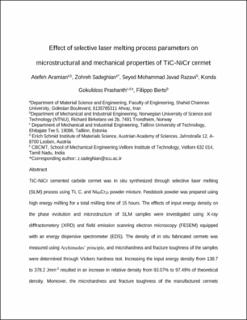| dc.contributor.author | Aramian, Atefeh | |
| dc.contributor.author | Sadeghian, Zohreh | |
| dc.contributor.author | Razavi, Seyed Mohammad Javad | |
| dc.contributor.author | Prashanth, Konda Gokuldoss | |
| dc.contributor.author | Berto, Filippo | |
| dc.date.accessioned | 2021-09-09T07:01:54Z | |
| dc.date.available | 2021-09-09T07:01:54Z | |
| dc.date.created | 2020-11-19T22:23:28Z | |
| dc.date.issued | 2020 | |
| dc.identifier.citation | Ceramics International. 2020, 46 (18), 28749-28757. | en_US |
| dc.identifier.issn | 0272-8842 | |
| dc.identifier.uri | https://hdl.handle.net/11250/2774796 | |
| dc.description.abstract | TiC–NiCr cermet was in situ synthesized through selective laser melting (SLM) process using a Ti, C, and Ni80Cr20 powder mixture. Feedstock powder was prepared using high energy milling and mixing for a total time of 15 h. The effects of input energy density on the phase evolution and microstructure of SLM samples were investigated using X-ray diffractometery (XRD) and field emission scanning electron microscope (FESEM) equipped with an energy dispersive spectrometer (EDS). The density of in situ fabricated cermets was measured using Archimedes’ principle, and microhardness and fracture toughness of the samples were determined through Vickers hardness test. Increasing the input energy density from 138.7 to 378.2 Jmm-3 resulted in an increase in relative density from 93.07% to 97.49% of theoretical density. Moreover, the microhardness and fracture toughness of the manufactured cermets increased to 1369.5 HV1 and 25.96 MPa m1/2, respectively. Further increasing of the energy density up to 416 J mm-3 resulted in lower density and increased porosities. Additionally, it resulted in a slight decrease in microhardness and fracture toughness. | en_US |
| dc.language.iso | eng | en_US |
| dc.publisher | Elsevier | en_US |
| dc.rights | Attribution-NonCommercial-NoDerivatives 4.0 Internasjonal | * |
| dc.rights.uri | http://creativecommons.org/licenses/by-nc-nd/4.0/deed.no | * |
| dc.title | Effect of selective laser melting process parameters on microstructural and mechanical properties of TiC–NiCr cermet | en_US |
| dc.type | Peer reviewed | en_US |
| dc.type | Journal article | en_US |
| dc.description.version | acceptedVersion | en_US |
| dc.source.pagenumber | 28749-28757 | en_US |
| dc.source.volume | 46 | en_US |
| dc.source.journal | Ceramics International | en_US |
| dc.source.issue | 18 | en_US |
| dc.identifier.doi | 10.1016/j.ceramint.2020.08.037 | |
| dc.identifier.cristin | 1850120 | |
| dc.description.localcode | "© 2020. This is the authors’ accepted and refereed manuscript to the article. Locked until 8-.8.2022 due to copyright restrictions. This manuscript version is made available under the CC-BY-NC-ND 4.0 license http://creativecommons.org/licenses/by-nc-nd/4.0/ " | en_US |
| cristin.ispublished | true | |
| cristin.fulltext | preprint | |
| cristin.qualitycode | 1 | |

